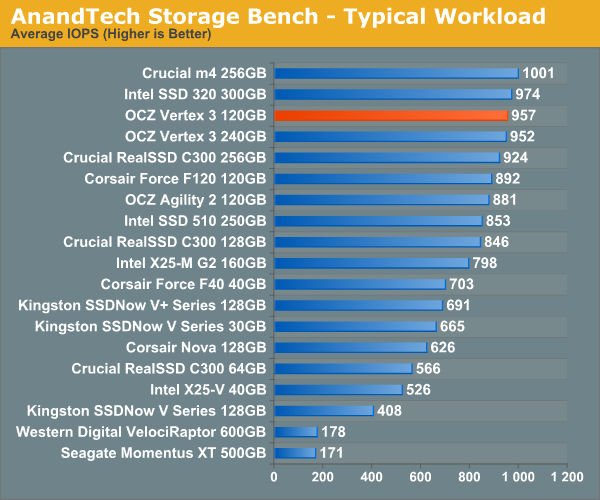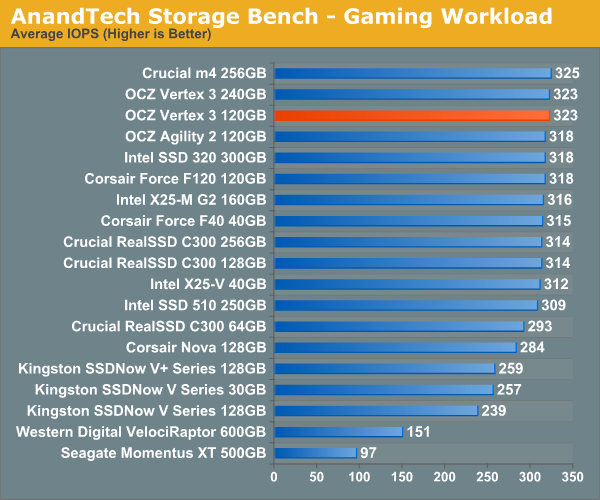The OCZ Vertex 3 Review (120GB)
by Anand Lal Shimpi on April 6, 2011 6:32 PM ESTAnandTech Storage Bench 2010
To keep things consistent we've also included our older Storage Bench. Note that the old storage test system doesn't have a SATA 6Gbps controller, so we only have one result for the 6Gbps drives.
The first in our benchmark suite is a light/typical usage case. The Windows 7 system is loaded with Firefox, Office 2007 and Adobe Reader among other applications. With Firefox we browse web pages like Facebook, AnandTech, Digg and other sites. Outlook is also running and we use it to check emails, create and send a message with a PDF attachment. Adobe Reader is used to view some PDFs. Excel 2007 is used to create a spreadsheet, graphs and save the document. The same goes for Word 2007. We open and step through a presentation in PowerPoint 2007 received as an email attachment before saving it to the desktop. Finally we watch a bit of a Firefly episode in Windows Media Player 11.
There’s some level of multitasking going on here but it’s not unreasonable by any means. Generally the application tasks proceed linearly, with the exception of things like web browsing which may happen in between one of the other tasks.
The recording is played back on all of our drives here today. Remember that we’re isolating disk performance, all we’re doing is playing back every single disk access that happened in that ~5 minute period of usage. The light workload is composed of 37,501 reads and 20,268 writes. Over 30% of the IOs are 4KB, 11% are 16KB, 22% are 32KB and approximately 13% are 64KB in size. Less than 30% of the operations are absolutely sequential in nature. Average queue depth is 6.09 IOs.
The performance results are reported in average I/O Operations per Second (IOPS):

If there’s a light usage case there’s bound to be a heavy one. In this test we have Microsoft Security Essentials running in the background with real time virus scanning enabled. We also perform a quick scan in the middle of the test. Firefox, Outlook, Excel, Word and Powerpoint are all used the same as they were in the light test. We add Photoshop CS4 to the mix, opening a bunch of 12MP images, editing them, then saving them as highly compressed JPGs for web publishing. Windows 7’s picture viewer is used to view a bunch of pictures on the hard drive. We use 7-zip to create and extract .7z archives. Downloading is also prominently featured in our heavy test; we download large files from the Internet during portions of the benchmark, as well as use uTorrent to grab a couple of torrents. Some of the applications in use are installed during the benchmark, Windows updates are also installed. Towards the end of the test we launch World of Warcraft, play for a few minutes, then delete the folder. This test also takes into account all of the disk accesses that happen while the OS is booting.
The benchmark is 22 minutes long and it consists of 128,895 read operations and 72,411 write operations. Roughly 44% of all IOs were sequential. Approximately 30% of all accesses were 4KB in size, 12% were 16KB in size, 14% were 32KB and 20% were 64KB. Average queue depth was 3.59.

The gaming workload is made up of 75,206 read operations and only 4,592 write operations. Only 20% of the accesses are 4KB in size, nearly 40% are 64KB and 20% are 32KB. A whopping 69% of the IOs are sequential, meaning this is predominantly a sequential read benchmark. The average queue depth is 7.76 IOs.











153 Comments
View All Comments
rarmstrongtaeus - Tuesday, May 8, 2012 - link
Hello, I am looking for any OCZ, or other SSD for that matter, that has the Hynix H27UBG8T2ATR NAND devices as shown in the image above. I am willing to pay a bounty of $500 plus the original cost of the drive for one of these drives as long as it is still functional. Please contact me at 719-306-5539jamesearlywine - Monday, October 22, 2012 - link
I bought a vertex 2, and within 3 months the drive just stopped working. I was able to get a replacement from OCZ because the drive was under warranty, but I lost data.I recently bought a vertex 3 about 8 months ago, a couple months ago the drive began disappearing. My laptop would freeze, and when it rebooted, it didn't detect the vertex 3.
I've heard there's a firmware upgrade that might fix this, but I have to backup the drive, install the firmware, then restore from system image.
If you buy an OCZ vertex 2 or 3, make sure to backup your data regularly. I have been severely disappointed by how unreliable these drives are, I bought two, and both purchases have been bad experiences.
axelsp76 - Thursday, June 5, 2014 - link
Hi Anand and everyone!! Thanks very much for this site. The amount of articles/comments here mesmerizing!Im having an issue with data transfer rates, and I cant get my head around it.
I really wanted to have better transfer rates on my desktop. Im not looking at RAID config at this stage.
I was hoping to get way above the 130 MB/s mark specially using sata III ports on my onboard Intel controller.
The motherboard is EVGA x79 Dark. And although I see spikes of 350MB/s on the first 3 seconds of the transfer rate (windows 8.1 copy details), its safe to say that most of the transfer is done at 130MB/s.
The BIOS has AHCI and ACPI enabled, and I checked that prior to the OS install.
Partition alignment on both drives seems to be ok (offset divisible by 4096) and both drives are about 1/3 from they total capacity. Both are 'twins' 120GB vertex 3 OCZ, purchased in one lot (but already about 3 years old)
The test i did was to transfer a 8Gb folder from SSD to the other. The difference I noted btwn copying a 8gb folder against a 8gb file is that in my case, the first 3 seconds are stable at 300+MB/s for the folder transfer, then it quickly drops to +-120MB/s till the end of the transf.
After reading this article, Im still unsure if I should go for another SSD brand (Samsung 840 pro or EVO), try an external sata controller.
Thanks!